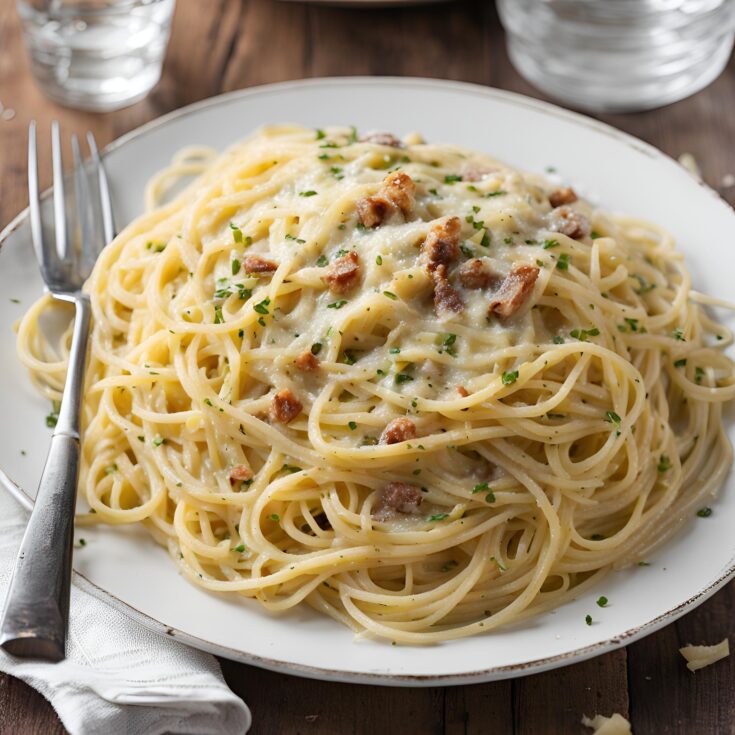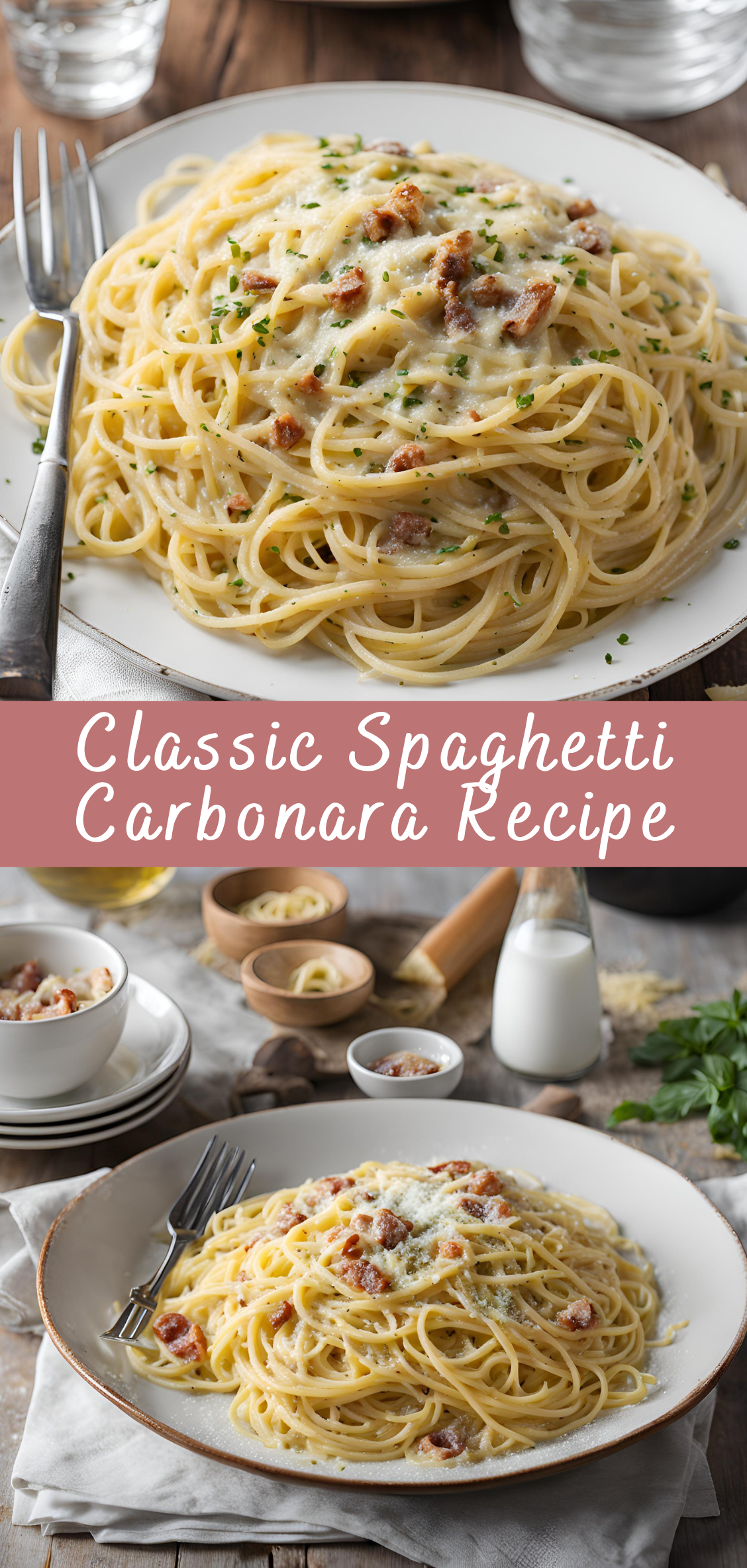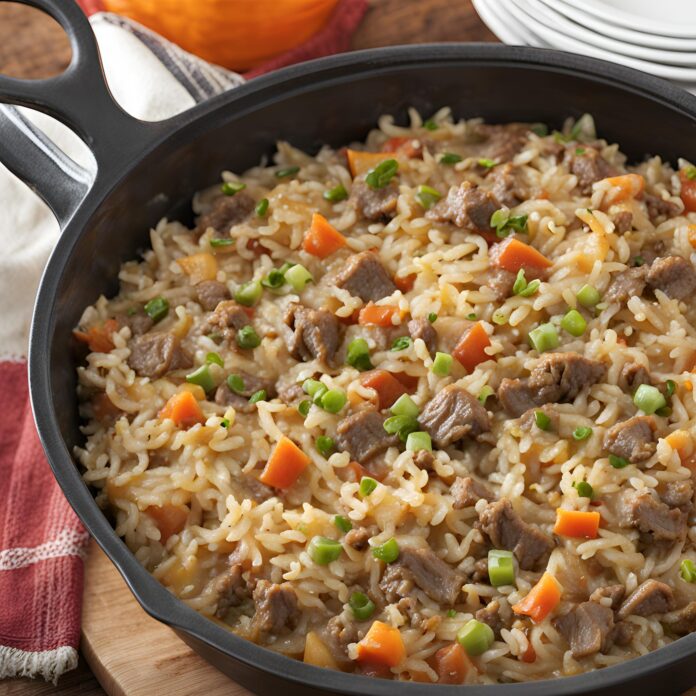Classic Spaghetti Carbonara Recipe
Spaghetti Carbonara is one of those classic dishes that feels both comforting and elegant at the same time. The creamy sauce, the crispy guanciale, and the peppery finish make it a timeless favorite. By following the traditional recipe, you’ll recreate a dish that is simple yet satisfying. Whether you stick to the authentic version or explore creative variations, you’ll be indulging in one of Italy’s greatest culinary treasures. Enjoy every creamy, peppery bite!

Instructions:
Step 1: Prepare the Pasta
- Bring a large pot of salted water to a boil. Add about 1 tablespoon of salt per liter (quart) of water. Once boiling, add the spaghetti and cook until al dente, following the package instructions (typically 8-10 minutes).
- Reserve a cup of pasta water before draining. This starchy water will help create a silky sauce later.
Step 2: Prepare the Guanciale
- While the pasta is cooking, heat a large skillet over medium heat. Add a small drizzle of olive oil or a small knob of butter to prevent the guanciale from sticking.
- Once hot, add the diced guanciale and cook it until crispy and golden brown, rendering the fat. This should take about 5-7 minutes. The goal is to crisp up the guanciale, not burn it, so make sure to stir occasionally.
- Remove from heat once it’s crispy and set aside, allowing it to cool slightly.
Step 3: Prepare the Egg-Cheese Mixture
- While the guanciale is cooking, in a large mixing bowl, whisk together the eggs, grated Pecorino Romano cheese, and a generous amount of freshly cracked black pepper.
- Whisk until smooth—this mixture should be thick but pourable. The cheese will melt into the eggs to create the creamy texture of the sauce later.
Step 4: Combine Pasta and Guanciale
- Once the pasta is done cooking, drain it (reserving about 1 cup of pasta water) and add it directly to the skillet with the guanciale. Stir the pasta and guanciale together so the pasta is coated with the rendered fat.
- Turn off the heat. This is important because you want to avoid scrambling the eggs when they are added. The heat from the pasta and the guanciale will be sufficient to cook the eggs without overcooking them.
Step 5: Toss with the Egg-Cheese Mixture
- Slowly pour the egg and cheese mixture over the pasta, tossing vigorously to combine. The residual heat from the pasta will cook the eggs, creating a creamy, rich sauce. Add some reserved pasta water a little at a time to adjust the consistency of the sauce. You want it creamy, not too runny or too thick.
Step 6: Serve
- Once the pasta is coated in the creamy sauce, taste and adjust seasoning. You may need more black pepper or salt, depending on how salty the guanciale and cheese are.
- Serve immediately with extra grated Pecorino Romano on top and a final crack of black pepper.
Key Tips for the Perfect Carbonara:
- Guanciale vs Pancetta:
- Guanciale (pork cheek or jowl) is the traditional meat for Carbonara. It has a richer flavor and more delicate texture than pancetta or bacon, which are often used as substitutes. Guanciale has a higher fat content and a smoother, melt-in-your-mouth quality, which creates the rich texture in the sauce.
- Pasta Choice:
- Spaghetti is the most traditional choice, but other pasta shapes like rigatoni, fettuccine, or even linguine can be used if you prefer.
- Eggs:
- Use fresh, high-quality eggs for the best result. The eggs are the foundation of the creamy sauce. Some variations use only egg yolks for a richer, more velvety texture, but the whole egg mixture works beautifully too.
- Cheese:
- Pecorino Romano is the cheese traditionally used in carbonara for its sharp, tangy flavor, though you can combine it with Parmesan if you prefer a less intense flavor.
- Pepper:
- Freshly cracked black pepper is crucial to the flavor profile of this dish. Don’t skip it—use a coarse grinder for a strong, bold kick.
- Avoid Cream:
- A classic carbonara does not include cream. The creaminess comes purely from the eggs and cheese, so stick to the traditional method.
History of Spaghetti alla Carbonara:
The origins of Carbonara are hotly debated, but it is generally believed to have emerged in central Italy—specifically in Rome—during the 20th century. While the dish is closely associated with Rome, it likely has roots in earlier recipes and the region’s culinary traditions. The name “carbonara” is thought to derive from “carbonari,” the Italian term for coal miners. There’s a theory that the dish was popularized by these miners, who would cook a simple meal of pasta with cured meat over an open flame. The rich sauce made with eggs and cheese was a perfect, easy way to create a filling, nourishing meal.
Another theory points to the post-World War II era, with the introduction of American ingredients like bacon and powdered eggs influencing the dish. Some believe that American soldiers stationed in Italy contributed to the development of carbonara as we know it today, though this remains speculative.
Variations and Modern Twists:
Though traditional carbonara follows a strict formula, there are variations that have emerged over time, especially outside of Italy. Some people may experiment with substituting bacon for guanciale, though this is not strictly traditional. Others may add garlic or onions for extra flavor, but this is not common in Roman-style carbonara.
- Vegetarian Carbonara: If you’re looking for a meatless version, try using mushrooms like cremini or shiitake in place of guanciale. The earthy flavor of mushrooms can mimic the richness of the pork.
- Carbonara with Chicken or Salmon: Some variations may use chicken or salmon, although these stray from the traditional Roman recipe.
- Spaghetti alla Carbonara with Truffle: For an upscale twist, try incorporating truffle oil or shaved truffles to enhance the earthy flavors of the dish.
Classic Spaghetti Carbonara Recipe

Spaghetti Carbonara is one of those classic dishes that feels both comforting and elegant at the same time. The creamy sauce, the crispy guanciale, and the peppery finish make it a timeless favorite. By following the traditional recipe, you’ll recreate a dish that is simple yet satisfying. Whether you stick to the authentic version or explore creative variations, you’ll be indulging in one of Italy’s greatest culinary treasures. Enjoy every creamy, peppery bite!
Ingredients
- 400g (14 oz) spaghetti
- 150g (5 oz) guanciale (or pancetta, if guanciale is unavailable), cut into small cubes or strips
- 4 large eggs (room temperature)
- 1 cup (about 100g) freshly grated Pecorino Romano cheese
- 1/2 cup (about 50g) freshly grated Parmesan cheese
- Freshly ground black pepper (to taste)
- Salt (for the pasta water)
Instructions
- Cook the pasta:
Bring a large pot of salted water to a boil. Add spaghetti and cook according to the package instructions until al dente. Reserve 1 cup of pasta water before draining. - Prepare the egg mixture:
While the pasta cooks, whisk together the eggs, grated Pecorino Romano, Parmesan, and a generous amount of freshly ground black pepper in a bowl. Set aside. - Cook the guanciale:
In a large skillet, heat a little olive oil (if necessary) over medium heat. Add the guanciale (or pancetta) and cook until it becomes crisp and golden, about 5–7 minutes. Turn off the heat. - Combine the pasta and guanciale:
Once the pasta is done, use tongs to transfer it directly into the skillet with the guanciale. Toss well to coat the pasta with the rendered fat. - Mix with the egg mixture:
Slowly pour the egg mixture into the hot pasta, stirring quickly to create a creamy sauce. Add some of the reserved pasta water, a little at a time, to help achieve the desired sauce consistency (it should be smooth and creamy). - Serve:
Serve immediately with extra grated cheese and black pepper on top.
Notes
- Guanciale is traditional, but if you can't find it, pancetta is a good alternative. Avoid using bacon, as it has a stronger flavor and isn’t quite as traditional.
- Make sure to toss the pasta off the heat when adding the egg mixture to avoid scrambling the eggs.
- The key to a creamy carbonara is to avoid using cream; the eggs and pasta water create the silky texture.
- The pasta water is crucial in adjusting the sauce's consistency, so don’t skip reserving it!



